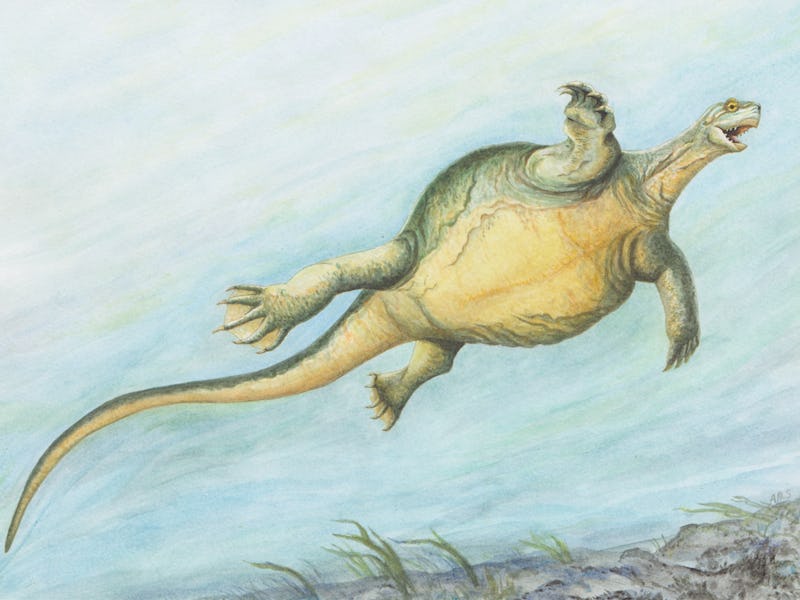Ancient Fossil of Happy Shell-Free Turtle Solves an Evolutionary Mystery
This smiling turtle was footloose and shell-free.

Of the modern turtle’s many distinct features, nothing stands out more than its iconic shell. But paleontologists have discovered a 228 million-year-old fossilized turtle that is not only missing its shell but is also sporting a turtle’s signature toothless beak, the earliest example to appear in the species. This discovery, accompanied with renderings of a bizarre but jolly-looking proto-turtle, sheds new light on how turtles may have evolved.
Eorhynchochelys sinensis, which essentially means “the first turtle with a beak from China,” was discovered by China Institute of Vertebrate Paleontology and Paleoanthropology researcher Chun Li, Ph.D., whose findings were published in the science journal Nature on Wednesday. Whereas another early turtle was once discovered with a partial shell and no beak, it was unclear how it fit into the reptile family tree until now. E. sinensis, this beak-bearing, shell-free creature, has filled a gaping hole in the turtle’s history and is considered evidence of a “mosaic evolution” whereby traits can evolve independently from each other and at different rates.
Illustration showing what Eorhynchochelys would have looked like in life, which is to say very pleased with itself.
“The origin of turtles has been an unsolved problem in paleontology for many decades,” says Olivier Rieppel, a paleontologist at Chicago’s Field Museum and co-author on the study. “Now with Eorhynchochelys, how turtles evolved has become a lot clearer.” Renderings of the turtle show its wide disc-like body unbound by a typical shell, smiling — presumably because it’s unburdened by a weighted shell — revealing its signature toothless beak.
Photograph of the actual fossil turtle Eorhynchochelys.
Eorhynchochelys is also answering some of the turtle’s many evolutionary mysteries. For years, scientists debated whether turtle ancestors were part of the same reptile group as today’s lizards and snakes, known as diapsids, or if they were anapsids, a reptile group that lacked two holes on the sides of their skulls. The shell-free turtle appears to settle the argument.
“With Eorhynchochelys’s diapsid skull, we know that turtles are not related to the early anapsid reptiles, but are instead related to evolutionarily more advanced diapsid reptiles. This is cemented, the debate is over,” says Rieppel.
The authors say they will continue to study the 228 million-year-old turtle for additional answers to an otherwise mysterious reptile, expecting more insight to appear after more tests. “Eorhynchochelys makes the turtle family tree make sense,” Rieppel explained. “Until I saw this fossil, I didn’t buy some of its relatives as turtles. Now, I do.”